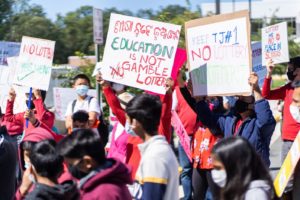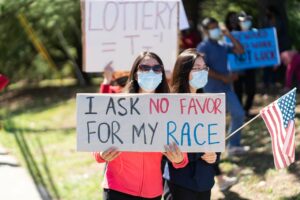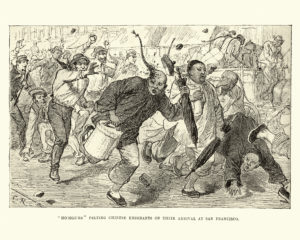A Primer on Critical Race Theory: An Interview with Dr. James Lindsay

Critical race theory has woven itself into almost every facet of our society, prioritizing “equity” over “equality.” While equal opportunity and equality before the law are foundational tenets of our country, critical race theory undermines those by prioritizing equity between racial groups, which forces us to separate individuals into arbitrary classifications and give some more opportunities than others.
Pacific Legal Foundation had the great privilege of sitting down with Dr. James Lindsay, a mathematician and co-author of the book Cynical Theories: How Activist Scholarship Made Everything about Race, Gender, and Identity―and Why This Harms Everybody to talk about critical race theory’s rising popularity and why everyone should be concerned with its implications for the preservation of the Fourteenth Amendment’s promise of equality before the law.
Jump to a section:
What is “critical race theory” and where did it come from?
How critical race theory uses language as a weapon
How critical race theory broke into the mainstream
Critical race theory comes for Asian Americans
Critical race theory and equality before the law
What is “critical race theory” and where did it come from?
PLF:
What is critical race theory?
James Lindsay:
Critical race theory is a way of looking at the world. In its own words, it describes itself as a movement of scholars and activists that is dedicated to transforming the relationship of race, racism, and power in society. So I think we can derive from that very quickly that it’s very focused on the idea of power.
If we take the “R” word out of the middle, you’re left with “critical theory.” To understand what critical race theory is requires you to understand what a critical theory is, because it’s critical theory applied to the idea of race. Critical theory started to be devised in the early 1920s in the Institute for Social Research in Frankfurt, Germany, better known as the Frankfurt School. Its objective was to analyze why Western societies are not prone to Communist revolutions.
A critical theory holds up a vision— a “normative vision of society” is how they phrase it—but what this means is essentially a perfected or idealized society. It analyzes how the existing society, and its systems, do not match that idealized vision and do not lend themselves to getting our society to that idealized vision. So they inspire “social activism.”
Where Karl Marx had his famous statement, “The philosophers have only interpreted the world, in various ways. The point, however, is to change it,” the point of critical race theory is to change it.
Critical theory was meant to be the counterpart to traditional theory as the theorists broke it apart. Where traditional theory is meant to understand the world, critical theory is meant to change the world towards this kind of Utopian vision, an idealized society where you would have an ideal democracy without systems of power that disenfranchise people through soft power, for example, rather than just deliberate exclusion like Jim Crow laws or segregation or something like that.
So when you apply this line of thought to race, you get critical race theory. And critical race theory therefore proceeds from a number of assumptions: that racism is the fundamental organizing principle of society and that it was created by white people to be imposed upon people of color so that they could disenfranchise minorities and control them through a kind of soft power.
It operates on what’s known as “conflict theory model” that holds that society is stratified so there are “haves” and “have nots” in society. There are the bourgeoisie, if you will, who have white privilege, and there are proletariat who are the masses of racial minorities who are being exploited.
The point of critical theory is to awaken the racial minority masses to realize their exploitation in an allegedly white supremacist and systemically racist system.
So critical race theory is a tool of analysis, if you want to call it that. It’s better to call it what they call it, which is a movement of scholars and activists who want people to understand the world in this way, with its primary and most important assumption being, again, that racism is the ordinary state of affairs in society and it is up to these people known as “critical race theorists” to be able to identify where racism is occurring, because of course it is occurring.
The saying, which Robin DiAngelo has specifically repeated many times in writing and in speech, is that the question is no longer did racism take place in any given situation, but rather how did racism manifest in that situation? And critical race theorists are the people empowered by having developed a critical race consciousness to be able to identify where racism is occurring in all phenomena and interactions and social circumstances. In other words, did racism manifest in this situation?
PLF:
Where did critical race theory come from and how does postmodernism play into this concept?
James Lindsay:
Critical race theory arose out of critical legal studies, which was occurring in Harvard Law. It was primarily led by its first tenured African American professor, Derrick Bell.
Professor Bell had a very pessimistic view of what was going on in post-civil rights America, saying that America had lost a lot of its enthusiasm, especially for things like affirmative action. Bell started to analyze, quite cynically, that what had happened in the civil rights movement was that America had just reinvented a raft of new problems for black Americans.
I don’t like to throw out this kind of analysis. What I find with critical race theory, and many of these analyses, is that they are pointing to something legitimate, but incorrectly.
I think it was the failed Great Society programs put in by Lyndon Johnson that were creating a raft of problems for African Americans and black Americans. Those problems were then being misdiagnosed as fundamental to the American project rather than the failure of progressive policy, which of course could never possibly be criticized from a progressive standpoint. I think that’s really what’s going on.
So [Bell’s] already creating the backdrop for critical race theory, which is the pessimistic way of analyzing these systems of power that are in place and saying they have something to do with race. His student at Harvard Law, Kimberlé Crenshaw, then takes it even further.
Bell and Crenshaw’s research is also related to postmodernism. Postmodernism is a French philosophy of society, with its own cynical and pessimistic approach. It’s very different though: where critical theory is what’s called “neo-Marxist” with the attempt of using cultural analyses to achieve Marxism, postmodernism is “post-Marxist” and has given up on the Marxist dream, so it’s just quite dour, pessimistic, and nihilistic.
In the early 1970s, English departments started taking up postmodern analysis in American universities. Feminists, in particular, were beginning to incorporate “deconstruction” to break down the concept of gender and were very interested in postmodern theory.
Deconstruction, in its purest form, is a practice of picking apart the binary oppositions by which we understand our world—fact and fiction, science and art, male and female—to be radically skeptical of categories on principle, and to doubt that words could ever refer straightforwardly to things in the real world or convey stable meaning.
The high deconstructive phase of postmodernism, most closely associated with Jacques Derrida, who is most famous for the deconstructive approach, took place in the late 1980s.
However, its practices of nitpicking and applying radical skepticism of categories, stable meaning, and objective truth, as well as its commitment to social constructivism, continued into various forms of cultural studies.
It is seen most strongly in queer theory and intersectional feminism, where the stable categories of the male and female sexes are regarded as oppressive and where gender roles as well as race relations are assumed to all have been constructed by dominant groups in society in order to oppress marginalized ones.
But Kimberlé Crenshaw’s big insight, which followed some of the other black feminists, was to consider that race is a category created by white people and imposed upon those people it oppresses.
She says, “Well, the postmodernists have the right idea that we should take this concept of race apart, but they have the wrong idea because they’re claiming that you can deconstruct something that’s being imposed, which is, in fact, an artifact of privilege.”
So, she starts claiming people like Michel Foucault and Derrida would have had white privilege in their society and therefore they didn’t understand that the racial identities that were being imposed on black women in particular, but black people overall, cannot be deconstructed.
This is where you start looking at Audre Lorde’s famous metaphor that the master’s tools cannot dismantle the master’s house, this kind of line of thinking.
They then narrowed down the racial experience to something they call “structural determinism.” What we hear is, “my lived experience” of being a racial minority in a racially biased system cannot be deconstructed.
You can’t get over racism merely by deconstructing it, but they had already adopted the critical theory mindset that liberalism itself—and this is what Derrick Bell was arguing—cannot overcome racism because it is baked into the liberal system because it was created by and for white people.
So they fuse this critical theory neo-Marxist mentality to the postmodern idea that knowledge is socially situated.
For the French postmodernist, it was what your culture is: Are you 17th-century French? Are you third-century Chinese? Whatever happens to be the actual cultural context. Are you high-society European? What are you? Are you a rootin’, tootin’, Wild, Wild West American? What are you?
You don’t know what it’s like to be a woman unless you are a woman. You don’t know what it’s like to be black unless you are black. So there’s this idea of so-called black community has a black culture, and white culture doesn’t like black culture, so now you have this idea of cultural racism.
Then they started to just develop these concepts where now each one of these identity groups is its own cultural thing and as a cultural thing, it has its—this being the postmodern aspect—own knowledge, its own approaches to knowing things, and that those things can’t be compared one against another and they actually can’t even be understood properly one against another. They are socially constructed and they socialize the members of those cultures to believe that what they’re engaging in is natural and reasonable.
So they took this and they added the idea that with the imposition of race, what you have is, again to use very Marxian language, this overarching white supremacist superstructure now being imposed upon an entire society, so that even if there is a black community with a unique black culture and a unique black voice, what that black culture is, what that black community experiences and what that black voice would have to say is all conditioned upon the structurally determinant force of this white supremacist superstructure, and this superstructure is the thing that has to be questioned or, ultimately, (again very Marxian) seized.
You have to seize the means of cultural production from the white supremacists now, rather than the capitalists, and you have to reorient society around that. And critical race theorists have positioned themselves as the vanguard, to use Leninist language, that’s going to be able to break into this position and do this to usher in a kind of post-racial equity-based Utopia.
How critical race theory uses language as a weapon
PLF:
In an earlier part of the interview, you brought up the word “equity,” which we thought was interesting because it appears to have replaced “equality.” In your book you write about language being used as a weapon by critical race theorists. Can you expand on this idea?
James Lindsay:
I mean, the whole thing is a linguistic project. There’s a beautiful essay that was written by a Catholic philosopher named Josef Pieper called Abuse of Language Abuse of Power. In the essay, he posits that when people are describing reality through a distorted lens, a theoretical lens as you might say with critical race theory, what they’re actually doing is playing a language game. They are using language in a specific way. It’s almost like creating a mythology—it’s creating a web of understanding where different concepts relate to other concepts.
This is very much what Derrida was talking about with discourses. Within this, I think is what he called it, “pseudo-reality,” it’s all linguistically constructed. It’s all about using manipulations of language to do what it does.
Of course, he would have had people like the Communists in mind because this is exactly what they did. Lenin defined the idea of the intelligentsia as people who agreed with him. So when Lenin was doing his Bolshevik Revolution, the people who were considered “intelligent” were the ones who believed in the Revolution.
Postmodernists like Derrida have played these language games with “democracy” and with “science.” I mean we could talk about “anti-racism” and “racism” and how they’ve fooled around with all these words and that’s approximate to our own experience. But I think a much more telling example, because it’s in perfect parallel, and it’s also still happening today, is if you read the testimony from Dr. Bella Dodd in 1953 where she testified to the House on the Un-American Activities Committee.
She claims then she was a defected Communist Party USA member. She testifies that the Communists will always dress up their movement in high-minded-sounding language. It’s not just that they distort the concepts for themselves, like democracy and science—they intentionally distort and use them in a self-serving way.
In particular, what the Communists in the 1930s and 1940s did was brand themselves as the “true” anti-fascists. If you were anti-Communist, they would say, “Well, Communists are anti-fascists, so you must be pro-fascism.”
You wouldn’t think that trick would work, but not only did it work then, it still works. It’s literally working on the Democratic party and has been to billions of dollars of damage unnecessarily over the last year. It’s unbelievable that Antifa can brand itself as anti-fascist as it goes around terrorizing things, but it’s the exact same linguistic trick.
It’s a twisting of language. Diversity now doesn’t mean diversity of skin color.
Now a “diverse” person has to be skilled in diversity, which means they have to be of those identities. Understanding them in the authentic way that structural determinism says that they should, which means, in other words, they have to be critical theorists of that particular identity in order to count as diverse. This is why Kanye West is not diverse because he put on a MAGA hat, and that made him not diverse anymore.
“Inclusion” means something different, too. It has something to do with making sure that the environment never produces any kind of offense for people who fall into these kind of allegedly disempowered groups, or vulnerable groups.
“Equity” comes from this model called social equity theory that was devised in the later 1960s where equity means readjusting shares so that people are made equal. The linguistic trick is that equity is positioned as though it’s like super equality. It’s like “equality plus,” but it’s actually just redistributing resources to make people have equal outcomes. They say it’s about creating equal access, but what they’ll do is jimmy around with the access point until we end up with equal outcomes. Whether they’ve tricked themselves or whether it’s deliberate is hard to say.
Anywhere you look, you can see “racism” now means a system of racism. It has nothing to do with your intentions, nothing to do with your beliefs, nothing to do with your behaviors, nothing to do with anything except that the system overall produces disparate outcomes.
That’s the sum total of what systemic racism means. I’ve got an encyclopedia I’m writing to define the hundreds upon hundreds of terms that they redefined to their purpose. They exist in Josef Pieper’s described “pseudo-reality” that they’ve created for themselves. One of the points Pieper raises is that once you become locked within a pseudo-reality, you think it’s reality and that everybody else occupies pseudo-realities.
The abuse of language is at the absolute center of their project because it’s trying to create a new linguistic lens or distortion field for how you interpret what you see in reality and it’s literally the entire vehicle of their project.
How critical race theory broke into the mainstream
PLF:
As you explained, critical race theory seemed to shoot into the mainstream over the past three to five years, but it didn’t just come out of nowhere. What is the explanation for this?
James Lindsay:
It’s obviously been cooking, to the great frustration of the scholars and academia, for—well, it depends on how you want to count it. We could count from Herbert Marcuse in the 1960s. We could count all the way back to the establishment of the Frankfurt School in 1923. We could count from the creation of critical race theory becoming a defined force in the 1990s. So, it had been cooking. And then in the 1990s, you actually can find a number of papers where you can tell the critical race theorists are quite frustrated that it’s not going anywhere. Even in the early 2000s, it’s not going anywhere and there’s quite a bit of frustration.
There are, to use the accursed word, structural elements that I think were unleashed by social media—the existence of social media and what social media enables people to do.
The internet skews young, so you have very young, idealistic people who are more prone to these ideas and who have also been indoctrinated in the school. Schools have been captured since the 1980s with this critical ideology. They call it “critical pedagogy,” using critical theory as a method of teaching and as a subject of teaching.
You add those structural forces in, and there are three primary cultural phenomena that have mainstreamed it over the last 10 years.
First was the way the narrative was spun, and maybe it’s not wholly inaccurate, around the election of Barack Obama. There was a racist reaction to this, throughout the Southeast for sure. I lived there; I saw it with my own eyes so I know it actually happened. I saw people wear T-shirts saying, “It’s called the White House for a reason,” with White underlined. It’s like, come on, guys.
So there was this reaction to the Obama presidency, and the media perpetuated this narrative: “Look how secretly racist America is.” At the same time, the critical race theorists are getting into education and the media, and becoming scholars, and start saying, “That’s what we’ve been saying all along. Racism didn’t go away, it just hid better,” which is a critical race theory belief.
I don’t think Obama’s platform in 2008 was as extreme as the divisive critical race theorists’ narrative. But there is a pretty compelling case that his bid in 2012 was a phenomenon that caused this leaning into identity politics.
The critical race theorists prioritize and prefer narrative-driven approaches to spreading their ideas. The narrative around Obama was effective at getting people to think, “Wow. Maybe America is actually secretly more racist than any of us believed coming out of the 1990s and into the early 2000s.” This primed the situation for people to accept critical race theory.
Then, suddenly in 2014, we have the shooting in Ferguson, Missouri. So the last part of 2014 and all through 2015 was this eruption of Black Lives Matter. An organization that had started very grassroots after Trayvon Martin was killed in Sanford, Florida, had become big. What people didn’t realize at the time is that it had been taken over by people who are using critical race theory as their analytical tool.
Black Lives Matter was very successful through 2014 and 2015 and even into 2016 before it kind of lost relevance for a while. Then along comes 2015, and especially 2016, when one Donald J. Trump decides he’s going to run for president as a complete outsider, and what did they say? “Racist, racist, racist, racist.” I mean, they called him everything else, sexist, misogynist, fascist, dictator. They called him all the things ableist.
Narrative is the weapon. But they really drove home that he’s racist. They tried to dig up how he or his father or somebody had disenfranchised black people in one of the apartment buildings or whatever the story was. They just tried to prove that he was a racist. It was so much so that I even wrote an essay in 2016 saying, “If you want Donald Trump to win, keep calling him racist,” and I was very horrified against Donald Trump at the time, so I was trying to urge my fellow liberals to stop using this weapon.
This continued not just through his campaign but once he got elected. They just drove it to an extraordinary degree to try to squash Donald Trump—to try to discredit and remove him. They used that very, very effectively to mainstream the underlying assumptions of critical race theory without people even knowing that it was critical race theory.
Meanwhile, they’re literally moving it into the schools quite explicitly. So now you’ve got this situation where it’s just permeated the entire environment and those three cultural phenomena—the reaction to Barack Obama’s presidency, the rise of Black Lives Matter. That primed the pump, and then during the election and presidency of Donald Trump, the accusations of racism and using the systemic racism argument really mainstreamed the ideas.
I think that’s how, to use the metaphor, the virus escaped the lab, where in the 1990s they were really complaining that the virus won’t escape academia, like, “We can’t figure out how to make this get out beyond legal review articles that nobody reads.”
Critical race theory comes for Asian Americans
PLF:
When critical race theorists talk about racial equality, why have Asian Americans been completely left out of the narrative? It seems like they are saying, “No, we care about minorities and equality; you don’t count.” Where does this come from?
James Lindsay:
Well, I have a friend named Kenny Xu, who wrote a book that I endorse and wrote a forward to. It’s called An Inconvenient Minority: The Attack on Asian American Excellence and the Fight for Meritocracy, and the title of that book tells you why.
Asian American is already a fraught term. It encompasses all sorts of backgrounds that may not have much in common: Koreans, Japanese, Chinese, Indian…
Having spoken with many Chinese American immigrants and children of immigrants, their families have placed a bet on escaping a literal Communist regime to come to the United States. This is true, also very commonly, of Vietnamese Americans, where they know that they have language barriers, they don’t have any social connections, they don’t have any of the kind of the social capital that might lead you to have what you call privilege in a society.
They have none of that. But they know if they get their kids to get really good grades and they get really successful in education, and then they go on and get really successful in college, and then get really successful as doctors or lawyers or whatever, the family is going to make it. If it’s Chinese, they might have the Confucian ethic where, “Now I made you get educated, you’re going to take care of mom.”
So they become a very inconvenient minority because their level of merit is tremendous, and it’s an even more inconvenient minority because the history in the United States against Asian Americans, or Asian American discrimination, is unbelievable.
For example, you have the internment of Japanese Americans during World War II. That’s a very poignant example.
Secondly, you have an historic Supreme Court case—Plessy v. Ferguson in 1896—where Justice John Marshall Harlan writes in his dissent that maybe it’s not constitutional to say that Chinese Americans are not created equal and it’s not constitutional to separate them. But he goes on to say that the Chinese race is alien and different to Americans. That’s pretty deep, and that doesn’t even touch on America’s one and only genuine attempt at ethnic cleansing, which was under the Chinese Exclusion Act.
The Chinese Exclusion Act, combined with miscegenation laws, essentially banned mixed-race marriages. The Act also made it virtually impossible for Chinese women to come into the United States. You have this large population of unmarriable men, which takes care of itself in one generation because none of them can get married, none of them can have kids under the existing legal structure. So Chinese Americans faced literally the only attempted ethnic cleansing in the history of the United States.
Then you compare that with the fact that in the mid-1990s, the vast majority of the students at the Specialized High Schools of New York and at the premier colleges, et cetera, were some mix of white, Jewish, black, and hispanic. Now it’s 73% Asian American and over 50% of the students at this super Specialized High School, and you think, “Oh, well, they’re buying their way. Crazy, rich Asians.” False. Over 50% are on free or reduced lunches. They are actually poor children of immigrants. They’re the poorest demographics with the fewest numbers of social connections and the highest level of academic attainment, and you see that, of course, at Thomas Jefferson high school for Science and Technology as well.
You see this in many of these very advanced, very high-prestige high schools throughout the country. What is happening is they’re filling up with high-merit, low-status Asian Americans who have been vigorously and viciously discriminated against throughout the entire history of the United States.
So this creates a very inconvenient minority, and all of a sudden what you have to do is you have to try to reframe this problem as being something other than what it is. Whereas the Chinese Exclusion Act might be able to be billed as “white supremacy,” you’re not seeing that now. What you’re seeing is that the Asians are “white-adjacent,” because they outperform whites, and the whole narrative is, of course, that that’s not supposed to happen.
In fact, I think almost all the different Asian American culture groups or ethnic groups outperform whites—whether they’re from India, China, Vietnam, Japan, it literally doesn’t matter.
This utterly blows away the narrative that we live in this white supremacist society, because we clearly do not. Asian Americans are killing it, no matter which part of Asia they seem to be from. And when you’re trying to make the claim that we have a superstructure of white supremacy that’s determining everybody’s outcome, that’s really inconvenient. Then when you actually look at the history and the circumstances that you’re dealing with, most of them today are in poverty, and you have literal discrimination against them that’s being defended by the government and our most prestigious universities.
We just saw with the Cruz amendment, for example, that the Democrats’ party line voted to maintain intentional discrimination against Asian Americans in colleges and universities in the United States.
That’s what is happening today. That’s not historical injustice. That’s happening currently and they’re still outperforming everybody. That’s a very inconvenient fact for a simplistic racial narrative. So what you have to do is, you have to start spinning all kinds of weird things, like they bought into white supremacy culture or that is just a piece of white supremacy culture, et cetera. Or you just don’t talk about it and keep the focus on other things, or you say, “Well, the Asian American communities are vigorously anti-black,” and then that’s associated with whiteness and that’s how they end up being described as white-adjacent.
Critical race theory and equality before the law
PLF:
Critical race theory is jeopardizing the constitutional protection of equality before the law by supporting equity and not equality. Can our country come back from this? Can equality before the law be saved?
James Lindsay:
I think we can come back from it. People are pretty mad about this. I want to make a point that it’s actually endemic to critical race theory. For example, there is a statement that comes straight out of the textbook Critical Race Theory: An Introduction, by Richard Delgado and Jean Stefancic. The first section in the book is titled “Section A: What is Critical Race Theory?” The first paragraph in that section ends with this sentence:
“Unlike traditional civil rights discourse, which stresses incrementalism and step-by-step progress, critical race theory questions the very foundations of the liberal order, including equality theory, legal reasoning, Enlightenment rationalism, and neutral principles of constitutional law.”
So what we have is a movement—in that paragraph they describe themselves as a movement, not a theory—a movement of activists and scholars who are trying to change the way we think about things so that we throw out ideas like equality, neutrality, legal reasoning, and Enlightenment rationalism. Lawyers are very rational people, I know, but legal reasoning—that’s basically rule of law. Neutrality before the law and the fact that constitutional law is, in fact, the highest law of the land. The very idea that equality before the law and, as religious people put it, before God, is all to be questioned is at the core of their project. That is fundamentally what they’re about, because their belief, again with that alleged white supremacist superstructure, is that there’s an imposition of race and racialization that, as their phrasing is, makes it so that the playing field is not level.
So what they want to do away with is equality before the law, because that way they can level the playing field for so-called equity. This is where you have, for example, Proposition 16 that came up in California in the last ballot, which asked to remove the anti-discrimination language from the California State Constitution.
This is totally consistent with one of critical race theory’s high priests. Ibram X. Kendi’s explicit statement from page 19 of his book, How To Be An Antiracist: “The remedy to past discrimination is present discrimination. The remedy to present discrimination is future discrimination.” In other words, they explicitly want to discriminate.
People working within law or within the intellectual side of things need to continually assert that the principle of equality before the law is, in fact, not just what people like Frederick Douglass called for in 1852 in his famous Fourth of July speech, not just what Martin Luther King called for in his famous I Have a Dream speech, not just what civil rights leaders who are still alive, like Bob Woodson, call for. But it is in fact the only way to ensure that whatever groups in society, especially the most vulnerable groups in society, are not going to be railroaded by corrupt powers.
Equality before the law is an absolutely bedrock principle in a nation that is going to be a nation of laws, in a nation that works to minimize corruption in the system. Certainly, the system is not perfect. Certainly, the system can be better and has been worse. But at the same time, if you want to achieve the minimization of corruption, you have to start with a principle of equality before the law.
So can it be saved? I think so. What has to be done, though, is that the case must be made clearly and persuasively that equality before the law was the right answer. Maybe we never quite got there, but we were getting pretty close, and it was creating the kind of society that we want to live in.
There is only a small group of agitators who believe in what amounts to a racially based Marxian superstructure, controlling all of society so that they can use that tool to foist a revolution where they become the arbiters of society.
If we throw out equality theory or neutrality, who do you think is going to get to decide what is going to be the right distribution, the right treatment?
We see this just happened recently in a Boston teaching hospital underneath Harvard. It has instituted, within at least one of its departments, a cardiology department, preferential admissions for patients, even against the evidence, by race.
If they’re doing this literally in medicine—preferential care by racial category—it’s around the corner for law, i.e., preferential treatment for exonerating circumstances.
Equality before the law, where the law doesn’t care who’s standing in front of them, whatever their skin color, whatever their ethnicity, whatever their national origin, or whatever it is, gender, sex, et cetera, is a bedrock principle to achieving a society where fairness is going to happen. If you want justice, if you even want whatever people think of as social justice, you better start with equality before the law.










